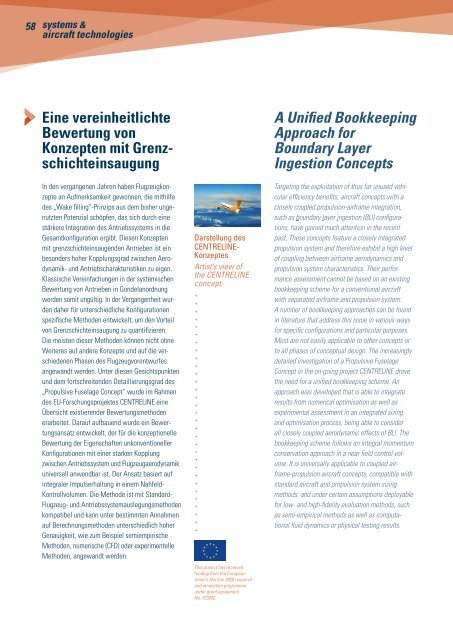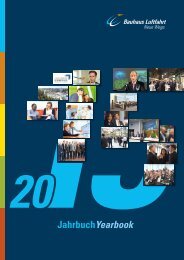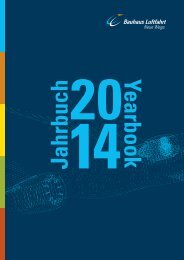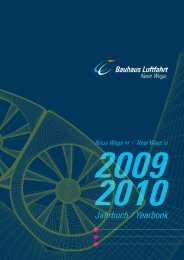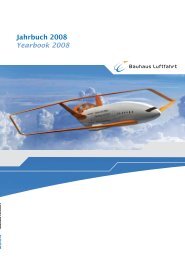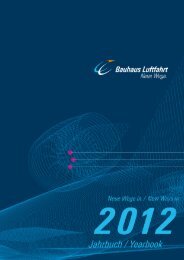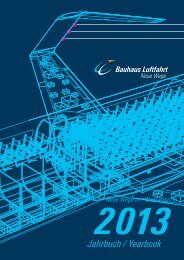Bauhaus Luftfahrt Jahrbuch 2018
Create successful ePaper yourself
Turn your PDF publications into a flip-book with our unique Google optimized e-Paper software.
58 systems &<br />
aircraft technologies<br />
Eine vereinheitlichte<br />
Bewertung von<br />
Konzepten mit Grenzschichteinsaugung<br />
In den vergangenen Jahren haben Flugzeugkonzepte<br />
an Aufmerksamkeit gewonnen, die mithilfe<br />
des „Wake filling“-Prinzips aus dem bisher ungenutzten<br />
Potenzial schöpfen, das sich durch eine<br />
stärkere Integration des Antriebssystems in die<br />
Gesamtkonfiguration ergibt. Diesen Konzepten<br />
mit grenzschichteinsaugenden Antrieben ist ein<br />
besonders hoher Kopplungsgrad zwischen Aerodynamik-<br />
und Antriebscharakteristiken zu eigen.<br />
Klassische Vereinfachungen in der systemischen<br />
Bewertung von Antrieben in Gondelanordnung<br />
werden somit ungültig. In der Vergangenheit wurden<br />
daher für unterschiedliche Konfigurationen<br />
spezifische Methoden entwickelt, um den Vorteil<br />
von Grenzschichteinsaugung zu quantifizieren.<br />
Die meisten dieser Methoden können nicht ohne<br />
Weiteres auf andere Konzepte und auf die verschiedenen<br />
Phasen des Flugzeugvorentwurfes<br />
angewandt werden. Unter diesen Gesichtspunkten<br />
und dem fortschreitenden Detaillierungsgrad des<br />
„Propulsive Fuselage Concept“ wurde im Rahmen<br />
des EU-Forschungsprojektes CENTRELINE eine<br />
Übersicht existierender Bewertungsmethoden<br />
erarbeitet. Darauf aufbauend wurde ein Bewertungsansatz<br />
entwickelt, der für die konzeptionelle<br />
Bewertung der Eigenschaften unkonventioneller<br />
Konfigurationen mit einer starken Kopplung<br />
zwischen Antriebssystem und Flugzeugaerodynamik<br />
universell anwendbar ist. Der Ansatz basiert auf<br />
integraler Impulserhaltung in einem Nahfeld-<br />
Kontrollvolumen. Die Methode ist mit Standard-<br />
Flugzeug- und Antriebssystemauslegungsmethoden<br />
kompatibel und kann unter bestimmten Annahmen<br />
auf Berechnungsmethoden unterschiedlich hoher<br />
Genauigkeit, wie zum Beispiel semiempirische<br />
Methoden, numerische (CFD) oder experimentelle<br />
Methoden, angewandt werden.<br />
Darstellung des<br />
CENTRELINE-<br />
Konzeptes<br />
Artist’s view of<br />
the CENTRELINE<br />
concept.<br />
+ + + + + + + + + + + + + + + + + + + + + + + + + + + + + + + + + +<br />
This project has received<br />
funding from the European<br />
Union’s Horizon 2020 research<br />
and innovation programme<br />
under grant agreement<br />
No. 723242.<br />
A Unified Bookkeeping<br />
Approach for<br />
Boundary Layer<br />
Ingestion Concepts<br />
Targeting the exploitation of thus far unused vehicular<br />
efficiency benefits, aircraft concepts with a<br />
closely coupled propulsion-airframe integration,<br />
such as boundary layer ingestion (BLI) configurations,<br />
have gained much attention in the recent<br />
past. These concepts feature a closely integrated<br />
propulsion system and therefore exhibit a high level<br />
of coupling between airframe aerodynamics and<br />
propulsion system characteristics. Their performance<br />
assessment cannot be based on an existing<br />
bookkeeping scheme for a conventional aircraft<br />
with separated airframe and propulsion system.<br />
A number of bookkeeping approaches can be found<br />
in literature that address this issue in various ways<br />
for specific configurations and particular purposes.<br />
Most are not easily applicable to other concepts or<br />
to all phases of conceptual design. The increasingly<br />
detailed investigation of a Propulsive Fuselage<br />
Concept in the on-going project CENTRELINE drove<br />
the need for a unified bookkeeping scheme. An<br />
approach was developed that is able to integrate<br />
results from numerical optimisation as well as<br />
experimental assessment in an integrated sizing<br />
and optimisation process, being able to consider<br />
all closely coupled aerodynamic effects of BLI. The<br />
bookkeeping scheme follows an integral momentum<br />
conservation approach in a near field control volume.<br />
It is universally applicable to coupled airframe-propulsion<br />
aircraft concepts, compatible with<br />
standard aircraft and propulsion system sizing<br />
methods, and under certain assumptions deployable<br />
for low- and high-fidelity evaluation methods, such<br />
as semi-empirical methods as well as computational<br />
fluid dynamics or physical testing results.


